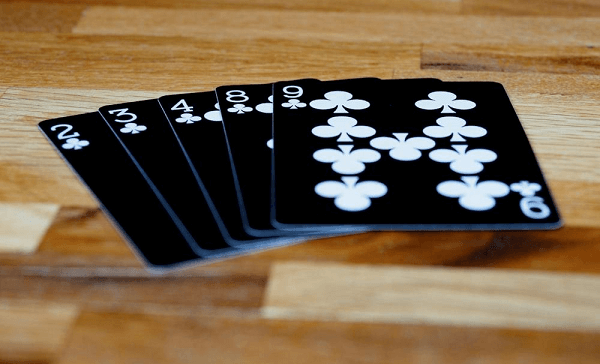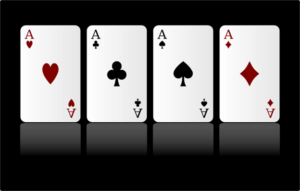How to Play 5 Card Draw Poker

5 card poker is considered by many to be one of the easiest forms of the classic card game of poker. The basic rules and concepts make it an ideal entry point for poker newbies across Australia.
In fact, 5 card draw poker is also the foundation of the classic casino game known as video poker. Today, it’s a popular poker format played in home games, but its popularity within casinos and poker rooms has waned significantly in recent decades.
In fact, very few poker events or series include 5 card poker as part of their games, instead preferring the likes of seven card stud and Texas Hold’em.
Below, we’ll explore the basis of 5 card draw poker, equipping you with all the rules and strategies needed to tackle the game.
What is 5 Draw Poker?
In 5 card poker, also known as 5 card draw poker, each player is dealt five hole cards. The game is played using a single 52-card playing deck, like other poker formats such as Texas Hold’em.
All five of the cards are dealt face-down from the dealer in the same way as the two hole cards are dealt in Texas Hold’em.
The main difference between 5 draw poker and Texas Hold’em is simply the number of hole cards. As each player is given a complete five-card hand from the dealer, it requires players to instantly play more strategically to try and manipulate their hole cards to build the best possible poker hand.
The betting structure of 5 card poker is another big differentiator to Texas Hold’em. In Texas Hold’em, there are multiple rounds of betting interspersed with the dealing of community cards.
In 5 card poker, there are usually just two rounds of betting – one before the drawing stage and one afterwards.
How to Play 5 Card Draw Poker
You’ll be pleased to know that 5 card poker is a relatively straightforward poker format to get your head around.
- 5 draw card poker tables usually accommodate between two and six players. With six players active at the table, this means there’s just 22 cards left in the dealer’s deck.
- That’s because 5 draw poker utilises only one 52-card deck. No additional decks are used under any circumstances.
- Your sole objective is to build the best possible five-card poker hand using your hole cards. The hand ranking used to denote winning players is the same in 5 draw poker as the one used in Texas Hold’em.
The Rules
If you’re a regular poker player of formats like Texas Hold’em and Omaha, the chances are you’ll be well-versed in the use of community cards. 5 card draw poker operates somewhat differently as it’s a draw poker variant.
That’s right, in 5 draw poker, there are zero community cards in action. This results in a very different kind of poker game. Below, we’ll run through every stage of a single hand of 5 card draw poker:
The Betting Rules
Most 5 card poker games are either fixed limit or pot limit games, unlike Texas Hold’em poker games, which are usually played as no-limit games.
This means there will either be a fixed amount you can raise by, or you’ll be limited by the pot size as to how much you can raise opponents.
The player to the immediate left of the big blind is still the first to act, like in Hold’em poker. In this position, you’ll have three options:
- Fold
Folding means discarding your five-card hand and your initial bet. - Call
Match the size of the big blind bet. - Raise
Raise the big blind bet by a fixed amount or the size of the pot.
The next player to the left then has the same decision to fold, call or raise. Once everyone has acted and decided whether to fold or remain in the hand, the round advances to the drawing stage.
The Drawing Stage

At this point, the small blind or the first active player closest to the small blind seat is given the first option to discard cards. In fact, you can discard as many cards as you wish in exchange for replacements from the dealer’s remaining deck.
If you do want to switch up your hand, pick up the cards you wish to discard and position them on the table in front of you. The dealer will return these cards to the deck and deal replacements.
The idea of the drawing stage is to try and improve your hand. If you have a drawing hand and you need another card or two to complete a hand, like a flush or straight, it could be worth replacing cards to see if luck is on your side.
If you’re already happy with the strength of your hand, you don’t have to discard any of your cards. This is known as “standing pat”.
The drawing stage moves clockwise around the poker table until all active players have acted. Once all players have completed their hands, the game advances to the second round of betting.
The Second Betting
The second round of betting follows the same pattern as the first round of betting. The small blind or the first active player to the left of the small blind acts first, with the action moving clockwise around the table.
The key difference between the second round and the first round is that you can decide to check. Checking means you don’t wish to fold your hand, but you don’t want to commit further chips to the pot either. You can try to check your hand through to the showdown so long as no other active player wants to raise you.
If one player is successful in making a bet sufficient to force all other players to fold, they win the pot without the need for a showdown.
The Showdown

If two or more players remain in the hand after the second betting round, the action advances to the final showdown.
Here, all remaining players turn over their five-card hands, and the dealer will compare all the hands using the same poker hand ranking used in Texas Hold’em.
The player with the highest-ranking hand will win the round and take down the pot.
Note: It’s important to remember that playing card suits don’t influence 5 card poker hand rankings. It’s possible to have flushes in different suits – the player with the highest card values in their flush wins the pot.
5 Draw Poker Strategies
As you become familiar with the concept of this poker format, it’s important to consider the merits of employing a 5 card draw poker strategy. In fact, there are a handful of basic 5 card draw poker tactics you can employ to give yourself even a modest edge over your opponents.
Below, we’ll explore three of the most important talking points in 5 draw poker strategy, which may also translate across into other poker variants too.
Knowing What Are Good Starting Hands
First and foremost, you need to familiarise yourself with the poker hand rankings. This can help you to understand immediately what a 5 card draw poker good starting hand looks like. Thus giving you the confidence to bet and show strength in the first and second rounds of betting.
Starting hand selection is the key to long-term success at the poker tables; whether you’re playing 5 draw poker, Texas Hold’em or Omaha. If you choose to get involved in too many hands with weak or even modest starting hands, the chances are your chip stack is going to dwindle over the medium-to-long term.
When you’re just starting out, the 5 draw poker good hands to play with are strong pocket pairs and encouraging draws like up and down straight draws or four cards of the same suit.
Tip: When you’re playing a hand in a late position, you may have the option to expand your playable hand range, especially if your opponents in early position have displayed weakness.
Bluffing
Bluffing in poker is one of the most important skills to master, as it can help you to win cheap pots at crucial times in the game. 5 draw poker bluffing is a little different than in other poker formats such as Texas Hold’em.
In Texas Hold’em, you usually get more information on the potential strength of your opponents’ hands. In 5 card draw poker, you get precious little information on your opponents’ holdings. This makes 5 card draw poker bluffing a little easier.
First and foremost, you must consider one of two things – the tendencies of the player(s) you’re planning to bluff and the number of cards a player exchanges.
The second point is especially vital as it can give you insight into the potential strength of their hands. For instance, they may have swapped a single card and are now making large bets.
This would suggest they have completed their drawing hand. It’s also a good idea to take note of those who originally stood pat with their hand to decide whether they are representing strength or simply looking to blag their way to showdown.
Drawing Cards
If this is the first drawing poker game you’ve ever played, you’ll need some advice on the drawing cards to opt for.
It’s by no means a black-and-white process, but there are several pointers we can provide to give you the best chance of improving your hand. Let’s run through the ideal 5 card draw poker drawing cards to get you started:
- If you’re holding a single pair, retain the pair and discard the other three cards.
- If you’re holding a three-of-a-kind, discard the remaining two cards.
- If you hold a two-pair hand, your kicker is the only drawing cards in 5 card draw poker you should consider swapping.
- If you’re holding four cards to a flush or straight, stand pat with the draw and only swap out the kicker card.
Final Thoughts
Overall, 5 draw poker is a great starting point for poker novices Down Under. With simple game and betting dynamics, it’s easy to get to grips with this as an entry-level poker option before attempting to master the likes of Texas Hold’em and Omaha.
The key to 5 draw card poker is getting to grips with your drawing cards, which can help to improve your hands more often.
If you’re getting into poker in a big way, make sure you head over to our blog, where you’ll find a library of articles discussing many other poker variants and strategies to get you up and running.






